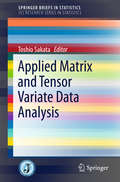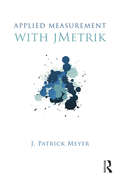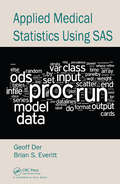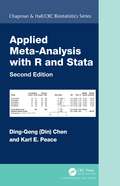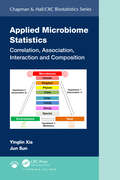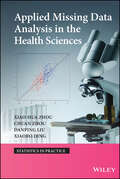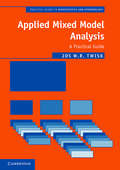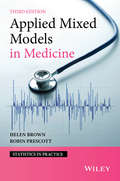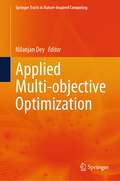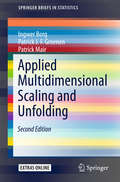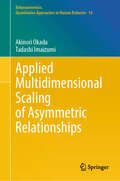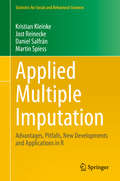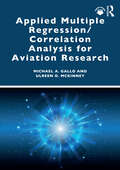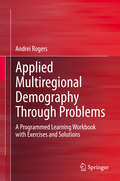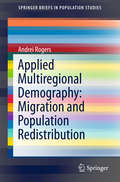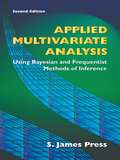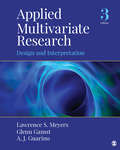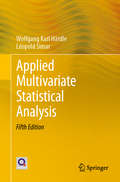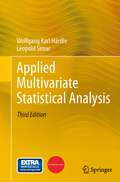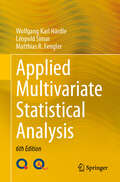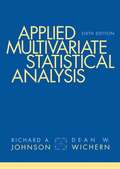- Table View
- List View
Applied Matrix and Tensor Variate Data Analysis (SpringerBriefs in Statistics)
by Toshio SakataThis book provides comprehensive reviews of recent progress in matrix variate and tensor variate data analysis from applied points of view. Matrix and tensor approaches for data analysis are known to be extremely useful for recently emerging complex and high-dimensional data in various applied fields. The reviews contained herein cover recent applications of these methods in psychology (Chap. 1), audio signals (Chap. 2) , image analysis from tensor principal component analysis (Chap. 3), and image analysis from decomposition (Chap. 4), and genetic data (Chap. 5) . Readers will be able to understand the present status of these techniques as applicable to their own fields. In Chapter 5 especially, a theory of tensor normal distributions, which is a basic in statistical inference, is developed, and multi-way regression, classification, clustering, and principal component analysis are exemplified under tensor normal distributions. Chapter 6 treats one-sided tests under matrix variate and tensor variate normal distributions, whose theory under multivariate normal distributions has been a popular topic in statistics since the books of Barlow et al. (1972) and Robertson et al. (1988). Chapters 1, 5, and 6 distinguish this book from ordinary engineering books on these topics.
Applied Measurement with jMetrik
by J. Patrick MeyerjMetrik is a computer program for implementing classical and modern psychometric methods. It is designed to facilitate work in a production environment and to make advanced psychometric procedures accessible to every measurement practitioner. Applied Measurement with jMetrik reviews psychometric theory and describes how to use jMetrik to conduct a comprehensive psychometric analysis. Each chapter focuses on a topic in measurement, describes the steps for using jMetrik, and provides one or more examples of conducting an analysis on the topic. Recommendations and guidance for practice is provided throughout the book.
Applied Medical Statistics Using SAS
by Brian S. Everitt Geoff DerWritten with medical statisticians and medical researchers in mind, this intermediate-level reference explores the use of SAS for analyzing medical data. Applied Medical Statistics Using SAS covers the whole range of modern statistical methods used in the analysis of medical data, including regression, analysis of variance and covariance, longitudi
Applied Meta-Analysis with R and Stata (Chapman & Hall/CRC Biostatistics Series)
by Karl E. Peace Ding-Geng (Din) ChenReview of the First Edition: The authors strive to reduce theory to a minimum, which makes it a self-learning text that is comprehensible for biologists, physicians, etc. who lack an advanced mathematics background. Unlike in many other textbooks, R is not introduced with meaningless toy examples; instead the reader is taken by the hand and shown around some analyses, graphics, and simulations directly relating to meta-analysis… A useful hands-on guide for practitioners who want to familiarize themselves with the fundamentals of meta-analysis and get started without having to plough through theorems and proofs. —Journal of Applied Statistics Statistical Meta-Analysis with R and Stata, Second Edition provides a thorough presentation of statistical meta-analyses (MA) with step-by-step implementations using R/Stata. The authors develop analysis step by step using appropriate R/Stata functions, which enables readers to gain an understanding of meta-analysis methods and R/Stata implementation so that they can use these two popular software packages to analyze their own meta-data. Each chapter gives examples of real studies compiled from the literature. After presenting the data and necessary background for understanding the applications, various methods for analyzing meta-data are introduced. The authors then develop analysis code using the appropriate R/Stata packages and functions. What’s New in the Second Edition: Adds Stata programs along with the R programs for meta-analysis Updates all the statistical meta-analyses with R/Stata programs Covers fixed-effects and random-effects MA, meta-regression, MA with rare-event, and MA-IPD vs MA-SS Adds five new chapters on multivariate MA, publication bias, missing data in MA, MA in evaluating diagnostic accuracy, and network MA Suitable as a graduate-level text for a meta-data analysis course, the book is also a valuable reference for practitioners and biostatisticians (even those with little or no experience in using R or Stata) in public health, medical research, governmental agencies, and the pharmaceutical industry.
Applied Metal Forming
by Henry S. ValbergApplied Metal Forming: Using FEM Analysis describes metal forming theory and how experimental techniques can be used to study any metal forming operation with great accuracy. For each primary class of processes, such as forging, rolling, extrusion, wiredrawing, and sheet-metal forming, it explains how FEA (Finite Elements Analysis) can be applied with great precision to characterize the forming condition and in this way optimize the processes. FEA has made it possible to build very realistic FEM-models of any metal forming process, including complex three-dimensional forming operations, in which complex products are shaped by complex dies. Thus, using FEA it is now possible to visualize any metal forming process and to study strain, stresses, and other forming conditions inside the parts being manufactured as they develop throughout the process.
Applied Microbiome Statistics: Correlation, Association, Interaction and Composition (Chapman & Hall/CRC Biostatistics Series)
by Jun Sun Yinglin XiaThis unique book officially defines microbiome statistics as a specific new field of statistics and addresses the statistical analysis of correlation, association, interaction, and composition in microbiome research. It also defines the study of the microbiome as a hypothesis-driven experimental science and describes two microbiome research themes and six unique characteristics of microbiome data, as well as investigating challenges for statistical analysis of microbiome data using the standard statistical methods. This book is useful for researchers of biostatistics, ecology, and data analysts. Presents a thorough overview of statistical methods in microbiome statistics of parametric and nonparametric correlation, association, interaction, and composition adopted from classical statistics and ecology and specifically designed for microbiome research. Performs step-by-step statistical analysis of correlation, association, interaction, and composition in microbiome data. Discusses the issues of statistical analysis of microbiome data: high dimensionality, compositionality, sparsity, overdispersion, zero-inflation, and heterogeneity. Investigates statistical methods on multiple comparisons and multiple hypothesis testing and applications to microbiome data. Introduces a series of exploratory tools to visualize composition and correlation of microbial taxa by barplot, heatmap, and correlation plot. Employs the Kruskal–Wallis rank-sum test to perform model selection for further multi-omics data integration. Offers R code and the datasets from the authors’ real microbiome research and publicly available data for the analysis used. Remarks on the advantages and disadvantages of each of the methods used.
Applied Missing Data Analysis in the Health Sciences
by Xaiobo Ding Danping Lui Xiao-Hua Zhou Chuan ZhouA modern and practical guide to the essential concepts and ideas for analyzing data with missing observations in the field of biostatisticsWith an emphasis on hands-on applications, Applied Missing Data Analysis in the Health Sciences outlines the various modern statistical methods for the analysis of missing data. The authors acknowledge the limitations of established techniques and provide newly-developed methods with concrete applications in areas such as causal inference methods and the field of diagnostic medicine.Organized by types of data, chapter coverage begins with an overall introduction to the existence and limitations of missing data and continues into traditional techniques for missing data inference, including likelihood-based, weighted GEE, multiple imputation, and Bayesian methods. The book's subsequently covers cross-sectional, longitudinal, hierarchical, survival data. In addition, Applied Missing Data Analysis in the Health Sciences features:Multiple data sets that can be replicated using the SAS®, Stata®, R, and WinBUGS software packagesNumerous examples of case studies in the field of biostatistics to illustrate real-world scenarios and demonstrate applications of discussed methodologiesDetailed appendices to guide readers through the use of the presented data in various software environmentsApplied Missing Data Analysis in the Health Sciences is an excellent textbook for upper-undergraduate and graduate-level biostatistics courses as well as an ideal resource for health science researchers and applied statisticians.
Applied Mixed Model Analysis: A Practical Guide (Practical Guides to Biostatistics and Epidemiology)
by Jos W. TwiskThis practical book is designed for applied researchers who want to use mixed models with their data. It discusses the basic principles of mixed model analysis, including two-level and three-level structures, and covers continuous outcome variables, dichotomous outcome variables, and categorical and survival outcome variables. Emphasizing interpretation of results, the book develops the most important applications of mixed models, such as the study of group differences, longitudinal data analysis, multivariate mixed model analysis, IPD meta-analysis, and mixed model predictions. All examples are analyzed with STATA, and an extensive overview and comparison of alternative software packages is provided. All datasets used in the book are available for download, so readers can re-analyze the examples to gain a strong understanding of the methods. Although most examples are taken from epidemiological and clinical studies, this book is also highly recommended for researchers working in other fields.
Applied Mixed Models in Medicine (Statistics in Practice #28)
by Helen Brown Robin PrescottA fully updated edition of this key text on mixed models, focusing on applications in medical research The application of mixed models is an increasingly popular way of analysing medical data, particularly in the pharmaceutical industry. A mixed model allows the incorporation of both fixed and random variables within a statistical analysis, enabling efficient inferences and more information to be gained from the data. There have been many recent advances in mixed modelling, particularly regarding the software and applications. This third edition of Brown and Prescott’s groundbreaking text provides an update on the latest developments, and includes guidance on the use of current SAS techniques across a wide range of applications. Presents an overview of the theory and applications of mixed models in medical research, including the latest developments and new sections on incomplete block designs and the analysis of bilateral data. Easily accessible to practitioners in any area where mixed models are used, including medical statisticians and economists. Includes numerous examples using real data from medical and health research, and epidemiology, illustrated with SAS code and output. Features the new version of SAS, including new graphics for model diagnostics and the procedure PROC MCMC. Supported by a website featuring computer code, data sets, and further material. This third edition will appeal to applied statisticians working in medical research and the pharmaceutical industry, as well as teachers and students of statistics courses in mixed models. The book will also be of great value to a broad range of scientists, particularly those working in the medical and pharmaceutical areas.
Applied Multi-objective Optimization (Springer Tracts in Nature-Inspired Computing)
by Nilanjan DeyThe book explains basic ideas behind several kinds of applied multi-objective optimization and shows how it will be applied in practical contexts in the domain of healthcare, engineering design, and manufacturing. The book discusses how meta-heuristic algorithms are successful in resolving challenging, multi-objective optimization issues in various disciplines, including engineering, economics, medical and environmental management. The topic is useful for graduates, researchers and lecturers in optimization, engineering, management science and computer science.
Applied Multidimensional Scaling and Unfolding (SpringerBriefs In Statistics)
by Ingwer Borg Patrick J.F. Groenen Patrick MairProvides a concise, largely conceptual introduction to multidimensional scaling and unfolding.<p><p> Focuses on how to actually run and interpret MDS and unfolding in applied research (with examples from psychology, the social sciences, and market research).<p> Explains with several examples how to use the R-package smacof for MDS/unfolding and Proxscal in SPSS.<p> Includes numerous R-scripts that show how to run MDS and unfolding analyses (a file containing all scripts, and more, can be downloaded).<p>This book introduces multidimensional scaling (MDS) and unfolding as data analysis techniques for applied researchers. MDS is used for the analysis of proximity data on a set of objects, representing the data as distances between points in a geometric space (usually of two dimensions). Unfolding is a related method that maps preference data (typically evaluative ratings of different persons on a set of objects) as distances between two sets of points (representing the persons and the objects, resp.).<p> This second edition has been completely revised to reflect new developments and the coverage of unfolding has also been substantially expanded. Intended for applied researchers whose main interests are in using these methods as tools for building substantive theories, it discusses numerous applications (classical and recent), highlights practical issues (such as evaluating model fit), presents ways to enforce theoretical expectations for the scaling solutions, and addresses the typical mistakes that MDS/unfolding users tend to make. Further, it shows how MDS and unfolding can be used in practical research work, primarily by using the smacof package in the R environment but also Proxscal in SPSS. It is a valuable resource for psychologists, social scientists, and market researchers, with a basic understanding of multivariate statistics (such as multiple regression and factor analysis).
Applied Multidimensional Scaling of Asymmetric Relationships (Behaviormetrics: Quantitative Approaches to Human Behavior #19)
by Akinori Okada Tadashi ImaizumiThis is the first book that focusses the attention on applying asymmetric multidimensional scaling (MDS) and describes how to apply it in a practical manner. The book provides the know-how for prominent methods of asymmetric MDS: analysis of asymmetric relationships and the efficient use of programs of asymmetric MDS based on a distance model. These features will facilitate the work of researchers and enlighten students in disciplines such as statistics, psychology, sociology, education, marketing science, medicine, education, and other fields. Support is provided for practitioners in these areas who are, for instance, developing new products or services, investigating dominance relationships among brands or products, researching the use of antibiotics against resistance bacteria, and developing items for tests. This informative book demonstrates the analyses of data from diverse areas to show how asymmetric relationships are prevalent in real-world relationships and helps readers grasp the meanings and implications of those relationships. The results of the analyses illustrate the importance of analyzing asymmetric relationships that cannot be perceived by analysis using traditional methods, which ignore asymmetry in the data.
Applied Multilevel Analysis
by Jos W. R. TwiskThis is a practical introduction to multilevel analysis suitable for all those doing research. Most books on multilevel analysis are written by statisticians; those books are difficult for non-mathematical researchers. In contrast, this volume provides an accessible account on the practical application of multilevel analysis in research. Many worked examples, with computer output, are given to illustrate and explain this subject. Datasets of the examples are available on the internet, so the reader can reanalyze the data. This approach will help bridge the conceptual and communication gap that exists between researchers and statisticians.
Applied Multiple Imputation: Advantages, Pitfalls, New Developments and Applications in R (Statistics for Social and Behavioral Sciences)
by Jost Reinecke Kristian Kleinke Daniel Salfrán Martin SpiessThis book explores missing data techniques and provides a detailed and easy-to-read introduction to multiple imputation, covering the theoretical aspects of the topic and offering hands-on help with the implementation. It discusses the pros and cons of various techniques and concepts, including multiple imputation quality diagnostics, an important topic for practitioners. It also presents current research and new, practically relevant developments in the field, and demonstrates the use of recent multiple imputation techniques designed for situations where distributional assumptions of the classical multiple imputation solutions are violated. In addition, the book features numerous practical tutorials for widely used R software packages to generate multiple imputations (norm, pan and mice). The provided R code and data sets allow readers to reproduce all the examples and enhance their understanding of the procedures. This book is intended for social and health scientists and other quantitative researchers who analyze incompletely observed data sets, as well as master’s and PhD students with a sound basic knowledge of statistics.
Applied Multiple Regression/Correlation Analysis for Aviation Research
by Michael A. Gallo Ulreen O. McKinneyApplied Multiple Regression/Correlation Analysis for Aviation Research describes and illustrates multiple regression/correlation (MRC) analysis in an aviation context, including flight instruction, airport design, airline routes, and aviation human factors research. Structured in four parts, the book first reviews the major concepts of bivariate correlation and regression and then extends the bivariate case to two, four, and k predictors coupled with discussions on statistical inference, underlying assumptions, and regression diagnostics relative to MRC analysis. The book then builds on this foundation by presenting MRC variable selection strategies (simultaneous, hierarchical, and statistical regression), analyzing sets of predictors, and introducing coding strategies for nominal predictors. The book concludes by presenting how MRC can be used to conduct an analysis of covariance (ANCOVA), interactions, mediation analysis, and binary logistic regression.Throughout the presentation, the book provides a balance between procedural knowledge as well as conceptual understanding. Detailed guided examples are presented at the end of each chapter that apply the topics and concepts of the chapter from the perspective of conducting a research study. The analytic strategies demonstrated via these guided examples are clearly explained, enabling readers to understand, conduct, and report results correctly. Pedagogical features associated with each chapter include a set of student learning outcomes and an end-of-chapter package that consists of a summary of the chapter’s main topics/concepts, a list of key terms, and review exercises, including multiple-choice items and a research scenario with data for students to analyze.Tailored to the needs of aviation students, Applied Multiple Regression/Correlation Analysis for Aviation Research is the ideal textbook for research-oriented graduate aviation programs such as a thesis-based master’s degree or doctoral program that require knowledge of advanced statistical strategies for analyzing research data.
Applied Multiple Regression/Correlation Analysis for the Behavioral Sciences Third Edition
by Jacob Cohen Patricia Cohen Stephen G. West Leona S. AikenA textbooks for behavioral scientists in statistics.
Applied Multiregional Demography Through Problems: A Programmed Learning Workbook with Exercises and Solutions
by Andrei RogersWritten by the 2018 Mindel C. Sheps Award winner, this textbook offers a unique method for teaching how to model spatial (multiregional) population dynamics through models of increasing complexity. Each chapter in this programmed workbook starts with a descriptive text, followed by a sequence of exercises focused on particular multiregional models, of increasing complexity, and then ends with the solutions.It extends the current developments in the spatial analysis of social data towards improving our understanding of dynamics and interacting change across multiple populations in space. Frameworks for analyzing such dynamics were first proposed in multiregional demography, over 40 years ago. This book revisits these methods and then illustrates how they may be used to analyze spatial data and study spatial population dynamics.Topics covered include spatial population dynamics, population projections and estimations, spatial and age structure of migration flows and much more. As such this innovative textbook is a great teaching and learning tool for teachers, students as well as individuals who want to study demographic processes across space.
Applied Multiregional Demography: Migration and Population Redistribution (SpringerBriefs in Population Studies #0)
by Andrei RogersThis book shows the effectiveness of multiregional demography for studying the spatial dynamics of migration and population redistribution. It examines important questions in demographic analysis and shows how the techniques of multiregional analysis can lead to answers that sometimes contradict conventional wisdom. The book reconsiders conclusions reached in the literature regarding several fundamental common sense demographic questions in migration and population redistribution, including: Is it mostly migration or "aging-in-place" that has been driving Florida's elderly population growth? Do the elderly return "home" after retirement more than the non-elderly do? Does longer life lead to longer ill-health? Do simple population projection models outperform complex ones? For each demographic question it reconsiders, the book begins with a simple empirical numerical example and with it illustrates how a uniregional specification can bias findings to favor a particular, and possibly incorrect, conclusion. It then goes on to show how a multiregional analysis can better illuminate the dynamics that underlie the observed population totals and lead to a more informed conclusion. Offering insights into the effectiveness of multiregional demography, this book serves as a valuable resource for students and researchers searching for a better way to answer questions in demographic analysis and population dynamics.
Applied Multivariate Analysis: Using Bayesian and Frequentist Methods of Inference, Second Edition (Dover Books on Mathematics)
by S. James PressGeared toward upper-level undergraduates and graduate students, this two-part treatment deals with the foundations of multivariate analysis as well as related models and applications. Starting with a look at practical elements of matrix theory, the text proceeds to discussions of continuous multivariate distributions, the normal distribution, and Bayesian inference; multivariate large sample distributions and approximations; the Wishart and other continuous multivariate distributions; and basic multivariate statistics in the normal distribution. The second half of the text moves from defining the basics to explaining models. Topics include regression and the analysis of variance; principal components; factor analysis and latent structure analysis; canonical correlations; stable portfolio analysis; classifications and discrimination models; control in the multivariate linear model; and structuring multivariate populations, with particular focus on multidimensional scaling and clustering.In addition to its value to professional statisticians, this volume may also prove helpful to teachers and researchers in those areas of behavioral and social sciences where multivariate statistics is heavily applied. This new edition features an appendix of answers to the exercises.
Applied Multivariate Research: Design and Interpretation
by Lawrence S. Meyers Glenn C. Gamst Anthony J. GuarinoUsing a conceptual, non-mathematical approach, the updated Third Edition provides full coverage of the wide range of multivariate topics that graduate students across the social and behavioral sciences encounter. Authors Lawrence S. Meyers, Glenn Gamst, and A. J. Guarino integrate innovative multicultural topics in examples throughout the book, which include both conceptual and practical coverage of: statistical techniques of data screening; multiple regression; multilevel modeling; exploratory factor analysis; discriminant analysis; structural equation modeling; structural equation modeling invariance; survival analysis; multidimensional scaling; and cluster analysis.
Applied Multivariate Research: Design and Interpretation
by Lawrence S. Meyers Glenn C. Gamst Anthony J. GuarinoUsing a conceptual, non-mathematical approach, the updated Third Edition provides full coverage of the wide range of multivariate topics that graduate students across the social and behavioral sciences encounter. Authors Lawrence S. Meyers, Glenn Gamst, and A. J. Guarino integrate innovative multicultural topics in examples throughout the book, which include both conceptual and practical coverage of: statistical techniques of data screening; multiple regression; multilevel modeling; exploratory factor analysis; discriminant analysis; structural equation modeling; structural equation modeling invariance; survival analysis; multidimensional scaling; and cluster analysis.
Applied Multivariate Statistical Analysis
by Wolfgang Karl Härdle Léopold SimarThis textbook presents the tools and concepts used in multivariate data analysis in a style accessible for non-mathematicians and practitioners. All chapters include practical exercises that highlight applications in different multivariate data analysis fields, and all the examples involve high to ultra-high dimensions and represent a number of major fields in big data analysis.For this new edition, the book has been updated and extensively revised and now includes an extended chapter on cluster analysis. All solutions to the exercises are supplemented by R and MATLAB or SAS computer code and can be downloaded from the Quantlet platform. Practical exercises from this book and their solutions can also be found in the accompanying Springer book by W.K. Härdle and Z. Hlávka: Multivariate Statistics - Exercises and Solutions.The Quantlet platform, quantlet.de, quantlet.com, quantlet.org, is an integrated QuantNet environment consisting of different types of statistics-related documents and program codes. Its goal is to promote reproducibility and offer a platform for sharing validated knowledge native to the social web. QuantNet and the corresponding data-driven document-based visualization allow readers to reproduce the tables, pictures and calculations presented in this Springer book.
Applied Multivariate Statistical Analysis
by Wolfgang Karl Härdle Léopold SimarMost of the observable phenomena in the empirical sciences are of a multivariate nature. In financial studies, assets are observed simultaneously and their joint development is analysed to better understand general risk and to track indices. In medicine recorded observations of subjects in different locations are the basis of reliable diagnoses and medication. In quantitative marketing consumer preferences are collected in order to construct models of consumer behavior. The underlying data structure of these and many other quantitative studies of applied sciences is multivariate. Focusing on applications this book presents the tools and concepts of multivariate data analysis in a way that is understandable for non-mathematicians and practitioners who need to analyze statistical data. The book surveys the basic principles of multivariate statistical data analysis and emphasizes both exploratory and inferential statistics. All chapters have exercises that highlight applications in different fields.The third edition of this book on Applied Multivariate Statistical Analysis offers the following new featuresA new Chapter on Regression Models has been addedAll numerical examples have been redone, updated and made reproducible in MATLAB or R, see www.quantlet.org for a repository of quantlets.
Applied Multivariate Statistical Analysis
by Wolfgang Karl Härdle Léopold Simar Matthias R. FenglerNow in its sixth edition, this textbook presents the tools and concepts used in multivariate data analysis in a style accessible for non-mathematicians and practitioners. Each chapter features hands-on exercises that showcase applications across various fields of multivariate data analysis. These exercises utilize high-dimensional to ultra-high-dimensional data, reflecting real-world challenges in big data analysis. For this new edition, the book has been updated and revised and now includes new chapters on modern machine learning techniques for dimension reduction and data visualization, namely locally linear embedding, t-distributed stochastic neighborhood embedding, and uniform manifold approximation and projection, which overcome the shortcomings of traditional visualization and dimension reduction techniques. Solutions to the book’s exercises are supplemented by R and MATLAB or SAS computer code and are available online on the Quantlet and Quantinar platforms. Practical exercises from this book and their solutions can also be found in the accompanying Springer book by W.K. Härdle and Z. Hlávka: Multivariate Statistics - Exercises and Solutions.
Applied Multivariate Statistical Analysis (6th Edition)
by Richard Arnold Johnson Dean W. WichernThis market leader offers a readable introduction to the statistical analysis of multivariate observations. Gives readers the knowledge necessary to make proper interpretations and select appropriate techniques for analyzing multivariate data. Starts with a formulation of the population models, delineates the corresponding sample results, and liberally illustrates everything with examples. Offers an abundance of examples and exercises based on real data. Appropriate for experimental scientists in a variety of disciplines.
